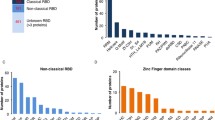Abstract
Plants are highly adapted to respond to a range of environmental stresses commonly by altering their gene expression and metabolism as a result of cell signalling which may be mediated by reactive oxygen species. The glycine-rich RNA-binding proteins ATGRP7 and ATGRP8 were rapidly upregulated in response to peroxide-induced oxidative stress and were amongst the most abundant RNA binding proteins isolated by oligo(dT) chromatography. The oligo(dT)-bound mRNP complexes were analysed proteomically, and were seen to contain potential isoforms of the ATGRP proteins; other proteins that contain an RNA Recognition Motif (RRM); and chloroplast RNA binding proteins. These findings suggest that ATGRP proteins have an evolutionarily conserved function in the regulation of gene expression at the posttranscriptional level in response to environmental stress.




Similar content being viewed by others
References
Desikan R, Mackerness S, Hancock JT, Neill SJ (2001) Regulation of the Arabidopsis transcriptome by oxidative stress. Plant Physiol 127:159–172
Wilson I, Neill SJ, Hancock JT (2008) Nitric oxide signalling in plants. Plant Cell Env 31:622–631
Neill SJ, Desikan R, Hancock JT (2002) Hydrogen peroxide signalling. Curr Op Plant Biol 5:388–395
Kazan K (2003) Alternative splicing and proteome diversity in plants: the tip of the iceberg has just emerged. Trends Plant Sci 8:468–471
Cheng Y, Chen X (2004) Posttranscriptional control of plant development. Curr Op Plant Biol 7:20–25
Wang QL, Li ZH (2007) The functions of microRNAs in plants. Front Biosci 12:3975–3982
Kim JS, Park SJ, Kwak KJ, Kim YO, Kim JY, Song J, Jang B, Jung CH, Kang H (2007) Cold shock domain proteins and glycine-rich RNA-binding proteins from Arabidopsis thaliana can promote the cold adaptation process in Escherichia coli. Nucl Acids Res 35:506–516
Kim JS, Jung HJ, Kim KA, Goh CH, Woo Y, Oh SH, Han YS, Kang H (2008) Glycine-rich RNA-binding protein7 affects abiotic stress responses by regulating stomata opening and closing in Arabidopsis thaliana. Plant J 55:455–466
Fu ZQ, Guo M, Jeong BR, Tian F, Elthon TE, Cerny RL, Staiger D, Alfano JR (2007) A type III effector ADP-ribosylates RNA-binding proteins and quells plant immunity. Nature 447:284–288
Streitner C, Danisman S, Wehrle F, Schöning JC, Alfano JR, Staiger D (2008) The small glycine-rich RNA binding protein AtGRP7 promotes floral transition in Arabidopsis thaliana. Plant J 56:239–250
Carpenter CD, Kreps JA, Simon AE (1994) Genes encoding glycine-rich Arabidopsis thaliana proteins with RNA-binding motifs are influenced by cold treatment and an endogenous circadian rhythm. Plant Physiol 104:1015–1025
Cao S, Jiang L, Song S, Jing R, Xu G (2006) AtGRP7 is involved in the regulation of abscisic acid and stress responses in arabidopsis. Cell Mol Biol Lett 11:526–535
Macknight R, Love K, Dean C (1998) Identification of an Arabidopsis cDNA encoding a novel glycine rich RNA-binding protein and mapping of the gene family onto the arabidopsis physical map. Plant Physiol 117:1526
Heintzen C, Nater M, Apel K, Staiger D (1997) AtGRP7, a nuclear RNA-binding protein as a component of a circadian-regulated negative feedback loop in Arabidopsis thaliana. Proc Natl Acad Sci USA 94:8515–8520
Staiger D, Zecca L, Kirk DA, Apel K, Eckstein L (2003) The circadian clock regulated RNA-binding protein AtGRP7 autoregulates its expression by influencing alternative splicing of its own pre-mRNA. Plant J 33:361–371
Schöning JC, Streitner C, Page DR, Hennig S, Uchida K, Wolf E, Furuya M, Staiger D (2007) Autoregulation of the circadian slave oscillator component AtGRP7 and regulation of its targets is impaired by a single RNA recognition motif point mutation. Plant J 52:1119–1130
Jumaa H, Nielsen PJ (1997) The splicing factor SRp20 modifies splicing of its own mRNA and ASF/SF2 antagonizes this regulation. EMBO J 16:5077–5085
Ladomery M (1997) Multifunctional proteins suggest connections between transcriptional and post-transcriptional processes. Bioessays 19:903–909
Ziemienowicz A, Haasen D, Staiger D, Merkle T (2003) Arabidopsis transportin1 is the nuclear import receptor for the circadian clock-regulated RNA-binding protein AtGRP7. Plant Mol Biol 53:201–212
Dresios J, Aschrafi A, Owens GC, Vanderklish PW, Edelman GM, Mauro VP (2005) Cold stress induced protein Rbm3 binds 60S ribosomal subunits, alters microRNA levels, and enhances global protein synthesis. Proc Natl Acad Sci USA 102:1865–1870
Ladomery MR, Slight J, McGhee S, Hastie ND (1999) Presence of WT1, the Wilm’s tumor suppressor gene product, in nuclear poly(A)(+) ribonucleoprotein. J Biol Chem 274:36520–36526
Nishiyama H, Higashitsuji H, Yokoi H, Itoh K, Danno S, Matsuda T, Fujita J (1997) Cloning and characterization of human CIRP (cold-inducible RNA-binding protein) cDNA and chromosomal assignment of the gene. Gene 204:115–120
Hancock JT, Henson D, Nyirenda M, Desikan R, Harrison J, Lewis L, Hughes J, Neill SJ (2005) Proteomic identification of glyceraldehyde 3-phosphate dehydrogenase as an inhibitory target of hydrogen peroxide in Arabidopsis. Plant Physiol Biochem 43:828–835
Lorković ZJ, Wieczorek Kirk DA, Klahre U, Hemmings-Mieszczak M, Filipowicz W (2000) RBP45 and RBP47, two oligouridylate-specific hnRNP-like proteins interacting with poly(A)+RNA in nuclei of plant cells. RNA 6:610–624
Sureban SM, Ramalingam S, Natarajan G, May R, Subramaniam D, Bishnupuri KS, Morrison AR, Dieckgraefe BK, Brackett DJ, Postier RG, Houchen CW, Anant S (2008) Translation regulatory factor RBM3 is a proto-oncogene that prevents mitotic catastrophe. Oncogene 27:4544–4556
Acknowledgments
Aline Marnef was supported by a Summer Vacation Studentship awarded by the Nuffield Foundation (URB/01948/G); and Fabian Schmidt was supported by the German Academic Exchange Programme and by the Faculty of Health and Life Sciences, University of the West of England, Bristol. This work was also supported by the German Research Council (DFG) through grant STA 653/2 to D.S. We wish to thank Jenna Slinn and Mervyn Lewis for technical assistance with MALDI-Tof mass spectrometry.
Author information
Authors and Affiliations
Corresponding author
Rights and permissions
About this article
Cite this article
Schmidt, F., Marnef, A., Cheung, MK. et al. A proteomic analysis of oligo(dT)-bound mRNP containing oxidative stress-induced Arabidopsis thaliana RNA-binding proteins ATGRP7 and ATGRP8. Mol Biol Rep 37, 839–845 (2010). https://doi.org/10.1007/s11033-009-9636-x
Received:
Accepted:
Published:
Issue Date:
DOI: https://doi.org/10.1007/s11033-009-9636-x




